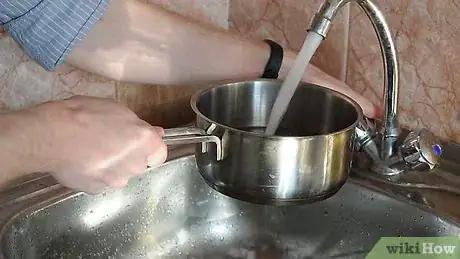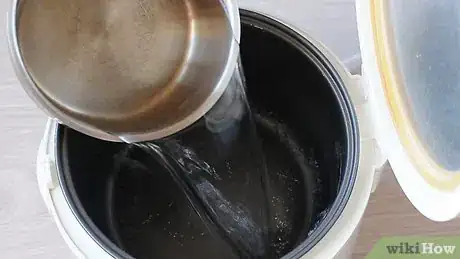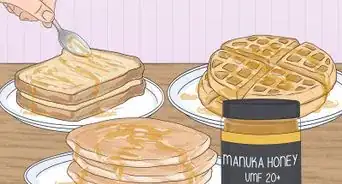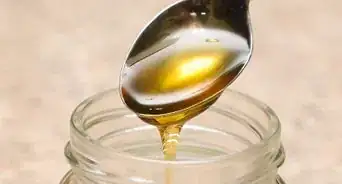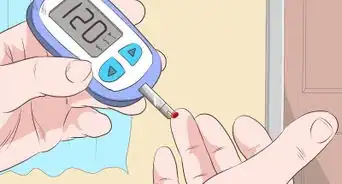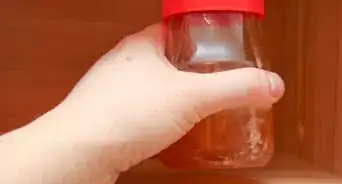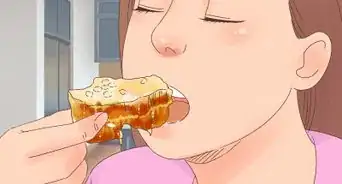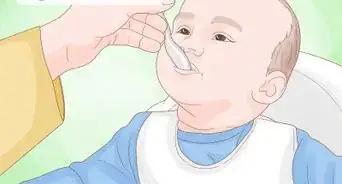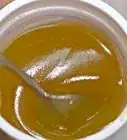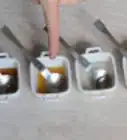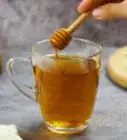This article was co-authored by David Williams. David Williams is a Professional Beekeeper and Bee Removal Specialist with over 28 years of beekeeping experience. He is the Owner of Bzz Bee Removal, a bee removal company based in the San Francisco Bay Area. Bzz Bee Removal locates, captures, and transports bees to local beekeepers to prevent colony collapse disorder.
wikiHow marks an article as reader-approved once it receives enough positive feedback. In this case, 100% of readers who voted found the article helpful, earning it our reader-approved status.
This article has been viewed 683,997 times.
Honey can last for many years, and there’s no need to toss it out if it crystallizes. This process is actually perfectly natural and helps preserve flavor in your honey![1] You still need to decrystallize it to make it easier to get it out of the bottle. You can return the honey back to its non-crystallized state using faucet water, boiling water, or a crockpot depending on the original container for your honey.
Steps
Decrystallizing Honey in a Plastic Bottle with Faucet Water
-
1Fill up a pot with hot water from your faucet. Turn the faucet(s) to full hot with no cold water being mixed in. You do not need to boil or microwave any water (this would melt the plastic); simply use the hottest setting your sink offers.
- Plastic begins to warp at temperatures above 140 °F (60 °C), but thankfully most residential water heaters will not keep water this hot.
-
2Place the plastic honey bottle upright in the water. Make sure the top of the honey container is peeking out from over the water so it does not flood with water. Do not lay the plastic bottle down on its side as this might allow water to leak into the honey.Advertisement
-
3Remove the bottle of honey from the sink once the water cools. When the water cools to near room temperature (which you can test with your finger), remove the honey and check for crystals. You can tilt the jar back and forth, checking to see if the honey moves easily. Or, try to squeeze the honey into a mug. If it doesn’t come out easily, there are probably still crystals in it.
-
4Repeat the process as needed until the honey is no longer crystallized. Check again after each iteration to see if honey will move around easily and come out of the bottle when you squeeze it. Once the crystals are gone, you can use the honey and store it back in a more consistently warm area in your kitchen.
- If your honey is not recrystallizing in the sink, you may need to try using boiling water.
Soaking a Glass Jar in Boiling Water
-
1Transfer your honey into a glass jar with a spoon. If your honey is stored in a plastic bottle, as most honey is today, twist the cap off of the honey and squeeze or spoon it into the glass jar (a mason jar will work well here). If the honey is too hard, try running the bottle under hot water from the faucet to soften the honey before squeezing the bottle again.
- Most plastic has a temperature limit of 140 degrees, and it will begin to deform if placed in close contact with boiling water.
- Water from the faucet, however, will not be hot enough to deform the plastic.
-
2Boil a pot of water on the stove. Fill a pot halfway with water and turn the heat up to high. Let it sit until the water reaches a rolling boil.[2]
- Alternatively, you could boil water in an electric kettle and then transfer that water to a pot.
-
3Remove the pot from the heat and place the honey jar into the pot. Once the pot is off the stove, add the jar of honey to the pot standing straight up, so that the water does not cover it.
- The water level should be close to the top of the honey jar, but it does not need to be submerged. If necessary, pour some of the water out of the pot so that it doesn’t cover the honey jar.
-
4Check the honey for crystals after 5 minutes and repeat the process if needed. Pull the jar out of the pot and move it side to side, with the cap on. Look for chunks of honey that don't appear to move when the honey is dripping back down the walls of the jar. If in doubt, repeat the process of boiling the water and heating the honey.
-
5Dry off and store your honey in a place that’s consistently warm. Set the honey in a cabinet that tends to keep warmer. Avoid keeping honey in areas that fluctuate between warm and cool often, near window sills or appliances with heating elements, for example.[3]
Using a Crock Pot to Decrystallize Honey
-
1Fill your crockpot partially with water. It’s a good idea to fill the crockpot to ¾ of the height of the honey jar, so that the water will not fully cover the honey jar. This will protect your honey from getting water into it.
-
2Set the crockpot on low and check the crockpot’s temperature. Put a thermometer in the water to check the water temperature, or check your crockpot’s manual to see what temperature the lowest setting is. If the crockpot’s lowest setting is below 140 °F (60 °C), you can simply put a plastic jar of honey right into the crockpot. Otherwise, you need to transfer the honey to a glass jar.
- Most crockpots’ lowest settings will be somewhere around 120 °F (49 °C), so you should be ok with a plastic jar of honey in most cases.
- Putting a plastic bottle in water that is over 140 °F (60 °C) could melt the plastic.
-
3Put the honey jar into the crockpot and let it sit for 8 hours. You do not need to completely submerge the honey, just fill the crockpot near the top of the jar. Check back in every couple of hours to make sure the water has not exceeded 140 degrees. If it has, turn the crockpot off and let it cool, then turn it back on and continue heating.
-
4Check on the honey after 8 hours and continue heating if necessary. Making sure the jar is not too hot (use gloves if you need to), remove the jar from the crockpot. Turn the jar side to side and look for any crystals or chunks that don’t move as well as the rest. If there are still crystals in the jar, continue heating in the crockpot and come back to check in another hour.
- Time will vary depending on how many jars of honey you are decrystallizing and how bad the crystallization was.
-
5Dry and store your honey somewhere warm if possible. Avoid having the same problem happen soon after by storing your honey somewhere where it is likely to stay warmer, if such a place is available. Don’t opt for the window sill or near the oven, where the temperature is likely to oscillate.[4]
- Keep honey in higher cabinets in your kitchen for additional warmth, as heat rises.
Expert Q&A
Did you know you can get expert answers for this article?
Unlock expert answers by supporting wikiHow
-
QuestionHow do you get honey back to a liquid?
 David WilliamsDavid Williams is a Professional Beekeeper and Bee Removal Specialist with over 28 years of beekeeping experience. He is the Owner of Bzz Bee Removal, a bee removal company based in the San Francisco Bay Area. Bzz Bee Removal locates, captures, and transports bees to local beekeepers to prevent colony collapse disorder.
David WilliamsDavid Williams is a Professional Beekeeper and Bee Removal Specialist with over 28 years of beekeeping experience. He is the Owner of Bzz Bee Removal, a bee removal company based in the San Francisco Bay Area. Bzz Bee Removal locates, captures, and transports bees to local beekeepers to prevent colony collapse disorder.
Beekeeper & Bee Removal Specialist
-
QuestionHow long can I keep honey in the bear container?
 Community AnswerForever, because honey doesn’t expire.
Community AnswerForever, because honey doesn’t expire. -
QuestionI was told that honey shouldn't be heated. Is it true?
 Community AnswerThe temperature in an active beehive reaches 95° F regularly (the bees actually work to keep it to that temperature). Raw honey, which has (at least theoretically) the most nutritive value, can be heated to that temperature. Heating honey hotter than that will alter some of the enzymes in it, but it doesn't harm the honey - it's still delicious and healthy. If you boil honey (bubbling hard) for over four hours, it apparently can grow substances that in large amounts may be carcinogenic - but for any normal use, no, there's no problem with heating honey.
Community AnswerThe temperature in an active beehive reaches 95° F regularly (the bees actually work to keep it to that temperature). Raw honey, which has (at least theoretically) the most nutritive value, can be heated to that temperature. Heating honey hotter than that will alter some of the enzymes in it, but it doesn't harm the honey - it's still delicious and healthy. If you boil honey (bubbling hard) for over four hours, it apparently can grow substances that in large amounts may be carcinogenic - but for any normal use, no, there's no problem with heating honey.
Things You’ll Need
- Pot
- Stove
- Mason jar
- Crockpot
- Spoon
Warnings
- Some sites recommend microwaving the honey, but do not use this method if you want your honey to maintain its good stuff. Microwaving the honey will destroy many of the beneficial enzymes and essential properties of the honey.⧼thumbs_response⧽
References
About This Article
To decrystallize honey that's stored in a plastic container, start by filling up a pot with hot water from your faucet. Next, place the plastic honey bottle upright in the water, making sure that the top of the honey container is not submerged. Then, let the hot water cool down naturally to room temperature and check the container again for crystals. You can repeat the process as many times as you need to until the honey is no longer crystallized! For tips on decrystallizing honey stored in a glass container, read on!
